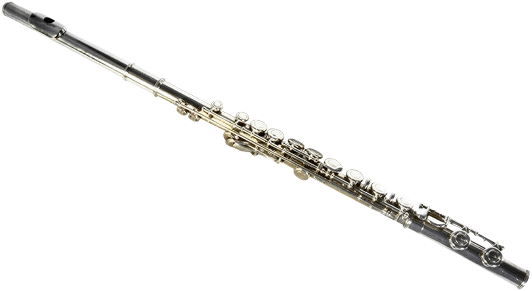How to Play the Flute
The flute is a great instrument, and many people enjoy playing it. Since I play the flute I can teach you. 1 is you should sit up straight so you can get a good tone out of the flute. It is easier to play the flute sitting up straight. 2 Hold your flute up. You’ve probably been told this but it can affect your tone if you hold your flute to low. 3 Balance the flute. There are three points of balance when holding a flute: the chin, left thumb, and the right thumb. The lip plate should rest in the hollow between your lip and chin, and you should feel a gentle pressure on the gums of your lower teeth. Your flute should rest just above the lowest knuckle of your left pointer finger, above where the finger meets the hand. The flute should rest on the tip of the right thumb, underneath or slightly behind the flute, between the F and E keys. Your right pinkie finger should then land naturally on the E flat key.[1] Once in this position it should feel very natural, and the flute should “float”, allowing you to produce a resonant sound. 4 Breath correctly. Take a deep breath with your belly, not your upper torso, before playing. You should see your belly physically expand. 5 Listen to your tone. . You can probably fix things yourself. Just think about sounding resonant and full. Imagine that you are vibrating the whole length of your flute. 6 Remember to support the air stream. In-tune notes always sound better, mainly in ensemble settings. 7 shape your lips. Making the hole in your lips smaller can produce a better tone. The air stream is more direct and you do not use as much air. On the other hand, make sure not to make the hole too small, or you can cut off the airflow and get an airy or forced sound. 8 Know that better tones on certain notes will come with time and familiarity. As you become more familiar with lower and higher notes on the flute, your tone will improve on them as well. Don’t just assume that time will solve everything however. It takes practice too! 9 Use vibrato on longer notes. Vibrato is a technique in which the player pitch bends very fast. Act like you are whispering “ha, ha, ha” and try to play a note.[2] It might sound unnatural at first, so practice until it is natural and even. Vibrato is a good technique that will create interest on longer notes and mask tuning inconsistencies as well. The speed of the vibrato depends upon the effect a flutist is trying to achieve; a faster vibrato often portrays a more intense feeling, while a slower vibrato is more soothing. 10 Have your flute serviced regulary. A flute that works better has a better tone. Period. If your tuning cork is messed up, a key is leaking, the rods are misaligned, or your flute is ailing in any other way, that will negatively affect your tone. To some extent you can fix things yourself–sticky keys or loose screws–but for most things have your flute checked at a music store. 11 Get a better flute. The quality of the metal (whether nickel, silver, or even gold) and the craftsmanship that went into making a flute drastically affect its tone. If you have a beginner’s flute consider buying a new one. Professional and intermediate flutes are crafted more precisely, and it is easier to get a good tone on many notes. Some features to consider: Open hole keys: These allow the air to go through when uncovered, and this leads to a fuller, more resonant tone. The open holes also create less air resistance, so it is easier to play notes. This is highly recommended, but it will take some adjustment once you switch because you will have to cover the holes completely with your fingers. Start out with plugs in the keys that are hardest to reach, so you can play normally, and work at playing without the plugs while you practice, In line G key: This is a matter of personal preference and wont really affect the tone. An in line G key just means that one key will be a bit harder to reach (see the image to the right). If you have small hands or are used to playing with an offset G key, it is fine to stick with that. The main reason an in line G key is preferred is for the pleasing look of the keys, B foot: You can purchase a foot joint with a few extra keys that enables you to play one chromatic step lower than usual (a B). This is a good idea because you will probably come across the note in advanced flute literature, Gizmo key: This key will almost always be included in a B foot and makes it easier to play high C or C# (5+ ledger lines)[3], Split E Mechanism: A split E mechanism divides the action of the upper and lower G keys. Normally the G keys close together; in a split E mechanism, that is still true, but the lower G can close when the third octave E natural is played. This provides ideal tone hole venting for the high E and can improve tuning and tone for a flutist,[4] Metal quality: Most beginning flutes are nickel or silver plated nickel. Pure silver (sterling silver) is the next quality up. If you are purchasing an intermediate flute, a pure silver headjoint or full flute is ideal. Next, there is the option of rose gold which can run about the cost of a nice car, and there are even platinum or titanium flutes!
• The most important part of the flute is the head joint, so if you cannot afford the body and foot joint, make sure to update the head joint’s metal quality at the least.
• Watch out for gold plated lip plates. They don’t affect tone at all and are just for looks.[5] However a better quality riser, the short “chimney” that attaches the lip plate to the head joint, does improve tone now you know how to play the flute.  Here is a flute in the box. You have to put it together.
Here is a flute in the box. You have to put it together.
 This is what a flute looks like when it is together. Hope you learned something.
This is what a flute looks like when it is together. Hope you learned something.

Hey Kyla this is Kyla from the smiletree
I love to play instruments especially the violin just last year I had a violin exam and earned a B+ . I also play the piano, have you herd of the song ” für eLisa” ? That is my favourite song to play on the piano on the violin I love ” hedwigs theme” anyway I do like your blog and please visit back at: http://smiletree.global2.vic.edu.au
😊 Kyla